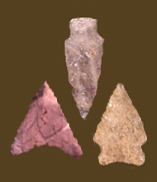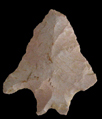
|
STANLY
Chronology The Stanly point dates to the Middle Archaic period. Chapman (1977) obtained radiocarbon dates for the type of 7790 +/- 215 BP and 7810 +/- 175 BP (approximately 6650 BC in calendar years) at sites in Tennessee. McAvoy and McAvoy (1997) recorded a date of 7420 +/- 160 BP (roughly 6300 BC) in association with Stanly period artifacts along the Nottoway River in Virginia. In New England, the Stanly is referred to as the Neville type, and has radiocarbon dates ranging from 5700 +/- 400 BC to 4610 +/- 100 BC (approximately 6450-5450 BC in calendar years), and dates from Pennsylvania also fall within this range (Dincauze 1971; Funk 1991; Kent 1996). Custer (1996a) suggests a date range of 7000 to 6200 BC in the Mid-Atlantic region, and Steponaitis (1980) places it between 7000 and 6000 BC (calendar years). Description Blade: The blade is triangular, broad, and commonly biconvex. The sides are most often incurvate, but can be straight or excurvate. There is frequently an angular projection at the shoulders, as well as evidence of re-sharpening. Most specimens are slightly serrated along the sides, although a few exhibit deep serrations. As a result of re-sharpening, some specimens are beveled. Haft Element: The base ranges from shallowly concave to a bifurcate notch, and is thinned. The stem is small, with parallel sides, and its height is usually equal to its width. However, in the Northeast (Neville type), the stem sides can be parallel, converging, or expanding, and the base can be straight (Kent 1996). While McAvoy and McAvoy (1997) noted grinding on the shoulders and some of the stem on points along the Nottoway River in Virginia, this trait is not always present. Coe (1964) noted that the stems of Stanly points were not ground at the Doerschuk site in North Carolina. Size: Length ranges from 40 to 80 mm, with an average of 55mm. Width ranges from 25 to 45 mm, with an average of 35 mm.Thickness ranges from 7 to 10 mm. Technique of manufacture: Large flakes were struck off with a soft hammer in the initial shaping of the preform, but pressure flaking was used to create the final edge and serrations. Material: In the area surrounding Zekiah Swamp on the lower Potomac, Wanser (1982) found that 80% of 45 Stanly points were quartzite, with 11% rhyolite, 7% quartz, and 2% chert. In the Monocacy River drainage, 74% of 23 Stanly points were rhyolite, while the rest were quartzite (Kavanagh 1982). In the Hagerstown Valley, most Stanly points are rhyolite (Stewart 1980), and rhyolite predominates in the middle Potomac River Valley as well, but other materials are also used (Hranicky 2002). In Western Maryland, Stanly points are commonly made from chert and rhyolite (Wall 1991). In Delaware, chert and jasper are preferred (Custer 1996a). Heat treatment of the stone sometimes occurs (McAvoy and McAvoy 1997). Discussion Coe (1964) suggested that there might be an evolutionary relationship between the Kirk Stemmed, Stanly, and Savannah River types. But he later indicated that the Kanawha Stemmed might be the ancestor of the Stanly, and Bettye Broyles pointed out that the two types could often be confused (Broyles 1971; Justice 1987). Others have noted a stylistic relationship between Stanly and Morrow Mountain points (Ward and Davis 1999). Chapman (1977) noted minor attribute differences within the Stanly point cluster in Tennessee, including examples with straight bases and little to no serration. McAvoy and McAvoy (1997) described a small variant of Stanly (length: 28 to 35 mm; width 20 to 25 mm; thickness: 4 to 6 mm) along the Nottoway River, which they assigned to the Middle Archaic period. A point variety with morphological similarities to Stanly/Neville was recovered in Late Archaic contexts at the Abbott Farm site complex in New Jersey (Wall et al. 1996). Defined in Literature Other Names Used Neville StemmedReferences |
![]()
Search by Shape:
(See Projectile Point Typology) |

|
Thank you for visiting our website. If you have any
questions, comments, Copyright © 2002 by |

|

 Defining Attributes
Defining Attributes